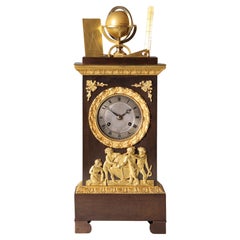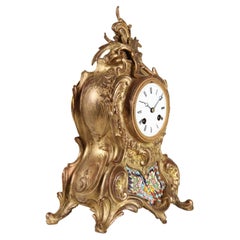Video Loading
Want more images or videos?
Request additional images or videos from the seller
1 of 17
19th Century Biedermeier Mantel Clock with Automated Face, circa 1820-1830
Price:$3,348.72
About the Item
- Dimensions:Height: 21.66 in (55 cm)Width: 14.97 in (38 cm)Depth: 7.49 in (19 cm)
- Style:Biedermeier (Of the Period)
- Materials and Techniques:
- Place of Origin:
- Period:
- Date of Manufacture:1820-1830
- Condition:Repaired: The hinge and the spiral spring for the movement of the mouth and eyes were worn out by years of use and have been replaced. The movements of the automaton work perfectly. Restored and very good condition of case and movement.
- Seller Location:Greven, DE
- Reference Number:1stDibs: LU5419233382972
About the Seller
5.0
Platinum Seller
Premium sellers with a 4.7+ rating and 24-hour response times
Established in 2014
1stDibs seller since 2020
207 sales on 1stDibs
Typical response time: 1 hour
Authenticity Guarantee
In the unlikely event there’s an issue with an item’s authenticity, contact us within 1 year for a full refund. DetailsMoney-Back Guarantee
If your item is not as described, is damaged in transit, or does not arrive, contact us within 7 days for a full refund. Details24-Hour Cancellation
You have a 24-hour grace period in which to reconsider your purchase, with no questions asked.Vetted Professional Sellers
Our world-class sellers must adhere to strict standards for service and quality, maintaining the integrity of our listings.Price-Match Guarantee
If you find that a seller listed the same item for a lower price elsewhere, we’ll match it.Trusted Global Delivery
Our best-in-class carrier network provides specialized shipping options worldwide, including custom delivery.You May Also Like
Biedermeier Mantel Clock, Early 19th Century
Located in Stahnsdorf, DE
Biedermeier Mantel Clock, Early 19th Century
A sophisticated Biedermeier mantel clock, crafted in Austria circa 1810–1830. This exceptional piece combines timeless elegance with out...
Category
Antique 1810s Austrian Biedermeier Mantel Clocks
Materials
Maple
Marble Mantel Clock with Matching Vases, circa 1830
Located in Greding, DE
A refined neoclassical garniture set comprising a marble mantel clock and two matching vases (20 x 13 x 13 cm). The clock features a vase-shaped body crafted in white marble with dar...
Category
Antique 1830s European Biedermeier Mantel Clocks
Materials
Marble
Mantel Clock with Genre Scene, Vienna 19th Century
Located in Greding, DE
Mantel clock in a gold-patinated wooden case with enameled clock face and octagonal pedestal with paw feet. The clock case rises above it in the shape of a wooden hut with a pointed ...
Category
Antique 19th Century Austrian Biedermeier Mantel Clocks
Materials
Wood
French Restoration Mantel Clock set, 1820-1830s
Located in Saint-Amans-des-Cots, FR
French Restoration bronze mantel clock set, France, 1820-1830s. 1 clock and two candelabras. Original golden patina 2 centuries old. Represents a Roman general seated at the height o...
Category
Antique 1830s French Charles X Mantel Clocks
Materials
Bronze
Early 19th Century Austrian Biedermeier Wall Clock
Located in Vancouver, British Columbia
A traditional Austrian Biedermeier wall clock featuring a rectangular carved and gilded wood frame clock face; surmounted by a gilt bronze winged eagle. The decorations on the frame ...
Category
Antique Early 19th Century Austrian Biedermeier Wall Clocks
Materials
Bronze
19th Century Empire Mantel Clock
Located in Ljungby, SE
An Empire mantel clock in gilded wood, made in Austria or Germany 1820-1830. It features a warrior dressed in classical armor with his arm resting atop the clock. The clock pillar is...
Category
Antique 19th Century European Empire Mantel Clocks
Materials
Wood
19th Century French mantel clock
Located in Brighton, Sussex
A very good quality late 19th Century French gilded ormolu and patinated bronze mantel clock, having a seated cherub holding the rains of a winged dragon pulling a scrolling foliate ...
Category
Antique 1880s French Louis XVI Mantel Clocks
Materials
Ormolu
19th Century Empire Mantel Clock
Located in Los Angeles, CA
Excellent condition with finely chased dore bronze mounts. Has key and pendulum.
Category
Antique Early 19th Century French Empire Mantel Clocks
Materials
Bronze
19th Century Boulle Mantel Clock
By Payne and Co. 1
Located in Brighton, Sussex
A very good quality 19th century French boulle mantel clock with wonderful scrolling foliate ormolu mounts to the surround, brass inlay to the red tortoiseshell. White enamel roman n...
Category
Antique Late 19th Century French Louis XVI Mantel Clocks
Materials
Tortoise Shell
Mantel Clock 19th Century Empire
Located in Warsaw, PL
Figural mantel clock signed “Al. dre Destape Palais Royal”
The bronze figural mantel clock depicting one of the mythical heroes - Orpheus originates from the Empire period. The cloc...
Category
Antique Early 19th Century French Empire Mantel Clocks
Materials
Bronze
More From This Seller
View All19th Century Biedermeier Picture Clock, Austria, circa 1830
Located in Greven, DE
Biedermeier picture clock with fountain mechanism
Austria
Oil on iron sheet
circa 1830
Dimensions: H × W × D: 45 × 53 × 14 cm
Description:
This rare picture clock depicts a villag...
Category
Antique 1820s Austrian Biedermeier Wall Clocks
Materials
Iron
19th Century Mantel Clock "Astronomy", France circa 1830
Located in Greven, DE
Antique mantel clock on the theme of astronomy
France
Bronze
Charles X around 1830
Dimensions: H x W x D: 48 x 19 x 10 cm
Description:
Unusual and beautifully crafted bronze mante...
Category
Antique 19th Century French Charles X Table Clocks and Desk Clocks
Materials
Bronze
Early 19th Century French Empire Mantel Clock, Portal Pendule, Paris circa 1820
By Duval
Located in Greven, DE
Antique French round arch portal clock
France (Paris)
Bronze, enamel
Empire circa 1820
Dimensions: H x W x D: 47 x 26 x 12 cm
Description:
Very beautiful, strictly architecturally...
Category
Antique Early 19th Century French Empire Mantel Clocks
Materials
Bronze, Enamel
Late 19th Century Cloisonne Mantel Clock, circa 1870-1890
Located in Greven, DE
French mantel clock with cloisonné inlays
Paris
Gilt bronze, enamel, movement by E. Gaillot, Paris
c. 1880
Dimensions: H 32 × W 23 × D 15 cm
Description:
Elaborately designed mant...
Category
Antique Late 19th Century French Mantel Clocks
Materials
Bronze, Enamel
19th Century French Louis XVI Style "Astronomy" Mantel Clock, circa 1845
By Perrelet
Located in Greven, DE
French mantel clock "Astronomy"
Paris
Bronze, marble
Mid 19th century
Dimensions: H x W x D: 38 x 55 x 16 cm
Description:
A Louis XVI-style figural mantel clock mounted on a two-t...
Category
Antique 1840s French Louis XVI Mantel Clocks
Materials
Marble, Bronze
Late 19th Century French Black Marble Mantel Clock
Located in Greven, DE
French Mantel Clock
Paris, circa 1870
Black marble with gilt bronze mounts
Dimensions: H × W × D: 41 x 23 x 12 cm
Description:
Case in black marble with richly chased and gilt bro...
Category
Antique Late 19th Century French Napoleon III Table Clocks and Desk Clocks
Materials
Marble, Bronze, Enamel
Recently Viewed
View AllMore Ways To Browse
Antique Fireplace Mantel Clocks
Antique Hour Glass
Antique Hour Glasses
Biedermeier Antique Clocks
Automated Clocks
Art Deco French Mantel Clocks
Brass Mantle
Antique Metal Mantel Clocks
Gilt Bronze Figural Clock
Louis Xv Ormolu Clocks
Antique Clock Bell
French Rococo Gilt Bronze Mantel Clock
Cherubs Garlands
Marble Carrara Clock
19th Century French Lyre Clock
Bronze Garniture Sets
Antique Wind Up
Cherub Plaque



